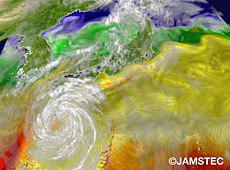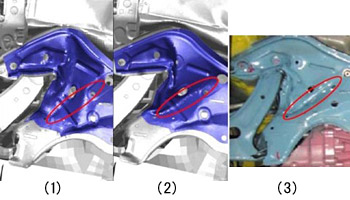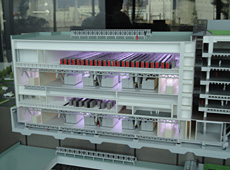Web Japan > Trends in Japan > Tech & Life > Japan's K Supercomputer
Japan's K Supercomputer
The Fastest Computer in the World
Executing Calculations at over 10 Petaflops (10 quadrillion calculations per second) In November 2011, Japan's K supercomputer, in a newly upgraded hardware configuration, achieved its original 10-petaflop target—the unprecedented feat of performing 10.51 quadrillion calculations per second—which is the fastest in the world to date. Just months ago in June, when it unveiled this latest supercomputer, with a calculation rate of 8.162 petaflops, Japan had already captured the supercomputer crown—it is three times faster than the runner-up, located in China.

|

|
Left: The K supercomputer is comprised of 864 cabinets that house the hardware. | |
| Enlarge photo | Enlarge photo |
Cross-sectional scale model of the building that houses the K supercomputer. K is cooled by water, requiring coolant to be circulated constantly throughout the building. (Photo: RIKEN Advanced Institute for Computational Science)
"Supercomputer" designates computers capable of calculating far faster than ordinary computers. Since 1993, the performance of supercomputers around the world has been compared by measuring how many times a computer can accomplish a certain calculation in one second. The ranking of supercomputer performance from first to 500th place based on this performance comparison is called the TOP500, with the top ranked on the list being deemed the fastest in the world. Japan has produced five of the world's fastest supercomputers in the past, and this year's top ranking marks the sixth world title for Japan and is the first time since its Earth Simulator attained first place on the TOP500 list, maintaining that spot from June 2002 to November 2004.
The K supercomputer is the product of a national project promoted by the Ministry of Education, Culture, Sports, Science and Technology and was developed by the research institute RIKEN and a Japanese manufacturer of large-scale computer systems, for a total of 100 billion yen. The designation "K" comes from the fact that the developers were aiming for per-second calculations of one "kei," the Japanese word for 10 quadrillion. So the K supercomputer has now achieved its original goal, measuring up to its name.
A high-performance supercomputer indicates the level of scientific and technological expertise that a nation has to offer, and an increasing number of countries are now competing to develop the world's fastest supercomputer. The announcement that Japan had captured first place in the TOP500 sparked celebrations across the country, with the train station nearest the RIKEN Advanced Institute for Computational Science, where the K supercomputer is housed, even being renamed as "K Computer Mae," (Station in front of the K Computer).
Powerful Performance for Scientific SimulationsThere are several reasons why a computational speed is the subject of competition. Supercomputers allow a wide array of scientific and technological simulations to be carried out, as an enormous volume of calculations can be performed in a short time. Thus, they can be employed to precisely demonstrate events such as natural disasters and simulate their effects without having to actually conduct and repeat onsite tests.
In weather-related applications, data on temperature, atmospheric pressure, wind direction, and other factors can be processed simultaneously. This allows meteorologists to predict typhoon movements, make long-term weather forecasts, and anticipate abnormal weather patterns across the globe.
Supercomputers are also useful in the automobile industry. Collision testing is an essential aspect of automotive design, helping to determine the type of design and the strength needed to protect passengers during a collision. Car manufacturers are beginning to replace the series of actual car collision tests they have conducted on test designs in the past with computer-simulated collisions.

Supercomputers play an active role in scientific and technological simulations. The figure above shows a typhoon simulation using the Earth Simulator to depict the 1998 Typhoon No. 15 nearing the Japanese archipelago. It shows the difference in the sea temperature: red indicates high and yellow low temperatures. The sea temperature drops as the surface water is stirred by strong winds. Storm surge forecasting is also possible when the local details such as levee height are available. ©JAMSTEC
Enlarge photoEarthquake mechanisms can be demonstrated by processing a vast amount of seismic data taken from affected areas. This enables researchers to conduct a thorough analysis of areas that strong seismic waves passed through and examine the main causes of collapsing structures and other damage.
Using the K to Perform More Sophisticated AnalysisBy using the K, researchers can calculate and process larger amounts of data than ever before in shorter periods of time, and obtain more accurate simulation results. In weather forecasting, it will be easier to anticipate phenomena such as heavy rainfalls that have occurred repeatedly in parts of Japan recently, which requires the processing of larger amounts of data from more monitoring points. For both automobile collision testing and earthquakes research, the K can dramatically shorten the time needed for research and development while enabling highly detailed damage analysis.
Developers are already working to improve K, striving to achieve the next target of one exaflop (1,000 quadrillion calculations per second). As the fastest ever, the Japanese K supercomputer will undoubtedly help to unveil astounding new revelations in a myriad of fields. It will continue to spur future scientific and technological advances that one can hardly imagine now.

|
Crumple simulation of automobile chassis floor in a collision (see red circled sections) using super computers. Compared to a simulation with conventional supercomputer (1), the result from a high-performance supercomputer capable of processing more than 10 times more data such as those on the chassis material and structure and speed of the car (2) is more consistent with the deformation seen in actual collision testing (3). This makes it possible to significantly reduce the number of collision tests using real vehicles. ©Japan Automobile Manufacturers Association, Inc. |
| Enlarge photo |

An example of a supercomputer simulation. The Earth Simulator analyzes seismic data at various locations in the southern part of Hyogo Prefecture (where the Hanshin-Awaji Earthquake struck) to produce planar and vertical images of how seismic waves travel. It enabled the main causes of collapsing buildings and other types of damage to be examined. ©Furumura, University of Tokyo
(January 2012)
- Super Competition (November 2005)


